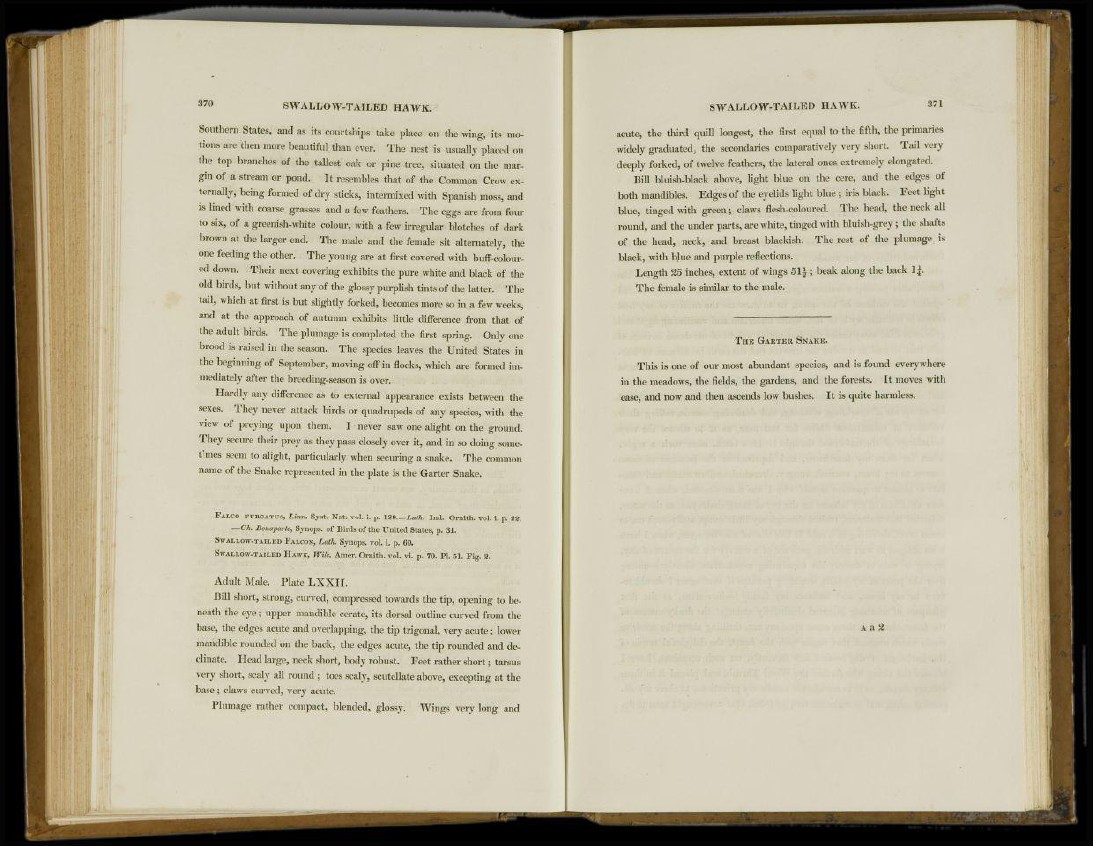
Southern States, and as its courtships take place on the wing, its motions
are then more beautiful than ever. The nest is usually placed on
the top branches of the tallest oak or pine tree, situated on the margin
of a stream or pond. It resembles that of the Common Crow externally,
being formed of dry sticks, intermixed with Spanish moss, and
is lined with coarse grasses and a few feathers. The eggs are from four
to six, of a greenish-white colour, with a few irregular blotches of dark
brown at the larger end. The male and the female sit alternately, the
one feeding the other. The young are at first covered with buff-coloured
down. Their next covering exhibits the pure white and black of the
old birds, but without any of the glossy purplish tints of the latter. The
tail, which at first is but slightly forked, becomes more so in a few weeks,
and at the approach of autumn exhibits little difference from that of
the adult birds. The plumage is completed the first spring. Only one
brood is raised in the season. The species leaves the United States in
the beginning of September, moving off in flocks, which are formed immediately
after the breeding-season is over.
Hardly any difference as to external appearance exists between the
sexes. They never attack birds or quadrupeds of any species, with the
view of preying upon them. I never saw one alight on the ground.
They secure their prey as they pass closely over it, and in so doing sometimes
seem to alight, particularly when securing a snake. The common
name of the Snake represented in the plate is the Garter Snake.
FALCO FUB-CATUS, Linn. Syst. Nat. vol. i. p. 129.—Lath. Ind. Ornith. vol. i p. 22.
—Ch. Bonaparte, Synops. of Birds of the United States, p. 3 1 .
SWALLOW-TAILED FALCON, Lath. Synops. vol. i. p. GO.
SWALLOW-TAILED HAWK, Wils. Amer. Ornith. vol. vi. p. 70. PI. 5 1 . Fig. 2.
Adult Male. Plate LXXII.
Bill short, strong, curved, compressed towards the tip, opening to beneath
the eye; upper mandible cerate, its dorsal outline curved from the
base, the edges acute and overlapping, the tip trigonal, very acute ; lower
mandible rounded on the back, the edges acute, the tip rounded and decimate.
Head large, neck short, body robust. Feet rather short; tarsus
very short, scaly all round ; toes scaly, scutellate above, excepting at the
base ; claws curved, very acute.
Plumage rather compact, blended, glossy. Wings very long and
acute, the third quill longest, the first equal to the fifth, the primaries
widely graduated, the secondaries comparatively very short. Tail very
deeply forked, of twelve feathers, the lateral ones extremely elongated.
Bill bluish-black above, light blue on the cere, and the edges of
both mandibles. Edges of the eyelids light blue ; iris black. Feet light
blue, tinged with green; claws flesh-coloured. The head, the neck all
round, and the under parts, are white, tinged with bluish-grey; the shafts
of the head, neck, and breast blackish. The rest of the plumage is
black, with blue and purple reflections.
Length 25 inches, extent of wings 51 £ ; beak along the back 1£.
The female is similar to the male.
THE GARTER SNAKE.
This is one of our most abundant species, and is found everywhere
in the meadows, the fields, the gardens, and the forests. It moves with
ease, and now and then ascends low bushes. It is quite harmless.
A a 2